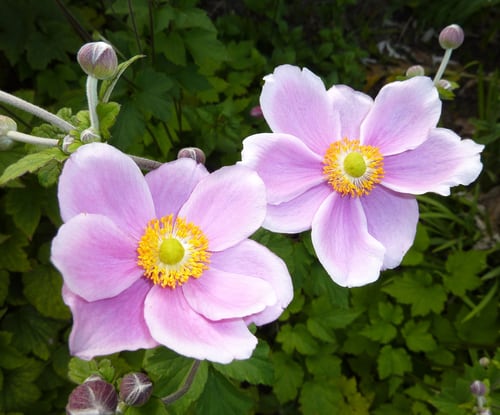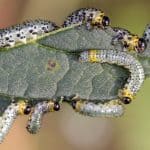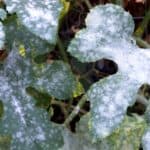Last updated on April 3rd, 2022
Our site is reader supported, this means we may earn a small commission from Amazon and other affiliates when you buy through links on our site.
If you want to have a late summer flowering garden, Japanese Anemones are a great addition. The flowers are held up on wiry stems and can be found in a variety of colours including pink, lavender, and white. You can find single or double flowers, all of which have yellow centres. They’ve been nicknamed the ‘Windflower’ because of how easily they dance in the wind.
These particular flowers differ from bulbing Anemones that otherwise bloom in spring. The Japanese Anemone is a perennial that flowers in the autumn so you can enjoy a range of colour at the end of summer, as long as you have an area that has moist soil with partial sun.
Native to China, these flowers were heavily cultivated in Japanese Gardens where they were seen first by European explorers during the 17th century. The late summer flowers and the dark green foliage that danced with the wind made them particularly attractive. They grow well in full sun or partial shade and can be quite tall so they will fill up the back of a layered space effectively. They spread via rhizomes but, you can remove errant plants easily in the spring.
 Anemone Wild Swan – Available from Amazon.co.uk
Anemone Wild Swan – Available from Amazon.co.uk
Where to Plant Japanese Anemones
If you live in a colder area, you should plant your Japanese Anemones close to a structure such as a fence or a wall, or a house so that they have extra protection against the winter weather. They make great perennials to plant along the border of your home or outdoor shed. If you don’t have such a space available you can grow them in a large container suitable to the size of the root system (once fully established) and place them in areas like patios or balconies where they still get that added protection thanks to the structures around the containers.
 Anemone Japonica Queen Charlotte
Anemone Japonica Queen Charlotte
When to Plant
You should plant new Japanese Anemones in the spring once there is no longer a risk of frost. The roots don’t like to dry out so you need to make sure wherever you plant them they will be able to stay moist, something you can provide with a little extra mulch. They do best with humus-rich soil and a mixture of compost. If you are planting more than one, space them out approximately 1/2 metre from one another because they do quickly fill out and area.
They prefer moist well-drained soil
As long as the soil is well-drained and stays moist, Japanese Anemones are quite forgiving. This means you don’t need to go out of your way to test the pH level or amend slightly sandy or clay-like soil. However, you still need to give them some regular care no matter the soil type.
Maintaining Japanese Anemones
Firstly, they will need compost in the spring. Secondly, to help with moisture retention and to prevent weeds from taking over you should add bark mulch every season around the base of the plant.

Support taller varieties with canes
Some varieties of Japanese Anemones can grow to over one metre in height and if you have the double-flowered varieties you might need to add some canes or some sort of support to prevent them from falling over.
Dividing plants
They will spread runners underground so after the first few years, you can divide an existing plant and transplant them elsewhere. To do this dig up the entire plant at the beginning of spring, divide them into fist-sized new plants, and replant them in similar conditions.
Learn more about dividing Japanese Anemones in this guide here
Winter care
In the winter, when the frost has killed the plants, you can cut them back to ground level and add compost over the top. Rest assured, they will come back in the spring just fine.
They do best when you grow them in groups and give them room to spread. They will also attract butterflies so you can add them to a wildlife garden or other woodland area where they can be allowed to spread naturally. If you need to pair them with other plants to fill the garden space, you can choose from ornamental grasses, hosta, and even monkshood, just to name a few.
Recommended Varieties
- If you want a white coloured variety that is an heirloom flower, “Honorine Jobert” is best.
- If you want a double, rose-pink variety, choose “Bressingham Glow”.
- For more limited space, there is a white variety that is slightly smaller called “Whirlwind”.
- If you want a touch of lavender, you can grow the “Kriemhilde”.
- For pink, semi-double flowers, try “Max Vogel”.
- This beautiful collection of Japanese Anemones are extremely hardy and undemanding plants. These will return year after year providing a beautiful display.
- These are perfect plants for attracting insects into your garden, with a host of windflowers rising above the attractive green foliage, helping pollination.
- These plants can provide you with many years of colour.
- 6 x Bare Root (2 of Each).
- Latin Name: Anemone x hybrida 'Honorine Jobert'
- Common Name: Japanese anemone 'Honorine Jobert'
- Characteristics: Deciduous perennial, white flowers with bright yellow stamens, blooms from late summer to early autumn, hardy
- Plant Advice: Your new Anemone Honorine Jobert will thrive when situated in full sun or partial shade. Flourishes best in moist but well drained soil and its robust nature is ideal for both exposed and sheltered areas. Cut back in late autumn and provide mulch cover over the winter to keep the plant healthy and looking its best.
- Latin Name: Anemone hupehensis 'Fantasy Jasmine'
- Common Name: Japanese Anemone 'Fantasy Jasmine'
- Characteristics: Deciduous perennial, pink flowers, blooms from late summer to early autumn, relatively hardy, easy to grow
- Plant Advice: Your new Anemone Fantasy Jasmine will thrive when situated in full sun or partial shade. Flourishes best in moist but well drained soil and its robust nature is ideal for both exposed and sheltered areas. Cut back in late autumn and provide mulch cover over the winter to keep the plant healthy and looking its best.
- Good quality product
- Made in UK
- Late-season colour: They provide a stunning display of pink and white flowers from August to October, filling borders and containers at the end of summer and into autumn.
- Attracts pollinators: Their flowers are a great source of nectar and pollen for bees, butterflies, and hoverflies during a crucial time for them
- Easy to grow: Once established, they are a very low-maintenance, hardy perennial that requires little care, though they appreciate a spring mulch to retain moisture
- ersatile for UK gardens: They thrive in partial shade, making them ideal for shadier spots, but will also tolerate full sun. They are suitable for borders, containers, and can add height to the middle or back of a border.
- Reliable: They are hardy and can withstand UK winter temperatures.
- Windflower Autumn Flowering Hardy Perennial Great for Polliantors
- Perfect for attracting pollinating insects to your garden, our Anemone Collection provides traditional blooms in vibrant colours.
- Hardy and resilient, these undemanding perennials will return year after year to provide fantastic colour.
- Our anemone mix provides an impressive display from late summer to autumn that looks great in both borders and containers.
- Bare root garden plant; 9 x Anemone Collection plants, 3 of each variety.
- Characteristics: Clump-forming herbaceous perennial shrub with toothed, maple-like foliage of bright green and slender stems holding semi-double with pale pink flowers.
- Growth & Spread: Ultimate height and spread of 0.1 – 0.5m.
- Period of Interest: Summer and Autumn interest. Upright stalks, sometimes branching, which carry single to semi-double white flowers with light violet-pink tinge and ruffled petals from mid-Summer to Autumn.
- Water & Maintenance: Plant in moist, fertile, humus-rich, well-drained soils. Keep in full or partial sun in any position. Avoid heavy, retentive soils and waterlogging, especially during Winter. Wind and frost protection advised.
- Pack of 20 corms that produces beautiful white single stemmed Poppy like flowers
- Perfect for planting in the borders or as part of a rockery display. Hardy perennial. Excellent naturalising plant, easy to grow, will multiply well and back each year
- Can be planted in autumn for flowering in April-June or in spring for flowering in June-August. Prefers a sunny position and look great in large groups.
- Also known as the Poppy Anemone. Full grown height 20-25cm.
- You will receive pack of 20 quality corms size 5/6 in recyclable packaging with detailed instructions included
Image credits – shutterstock.com
Last update on 2025-12-10 / Affiliate links / Images from Amazon Product Advertising API












